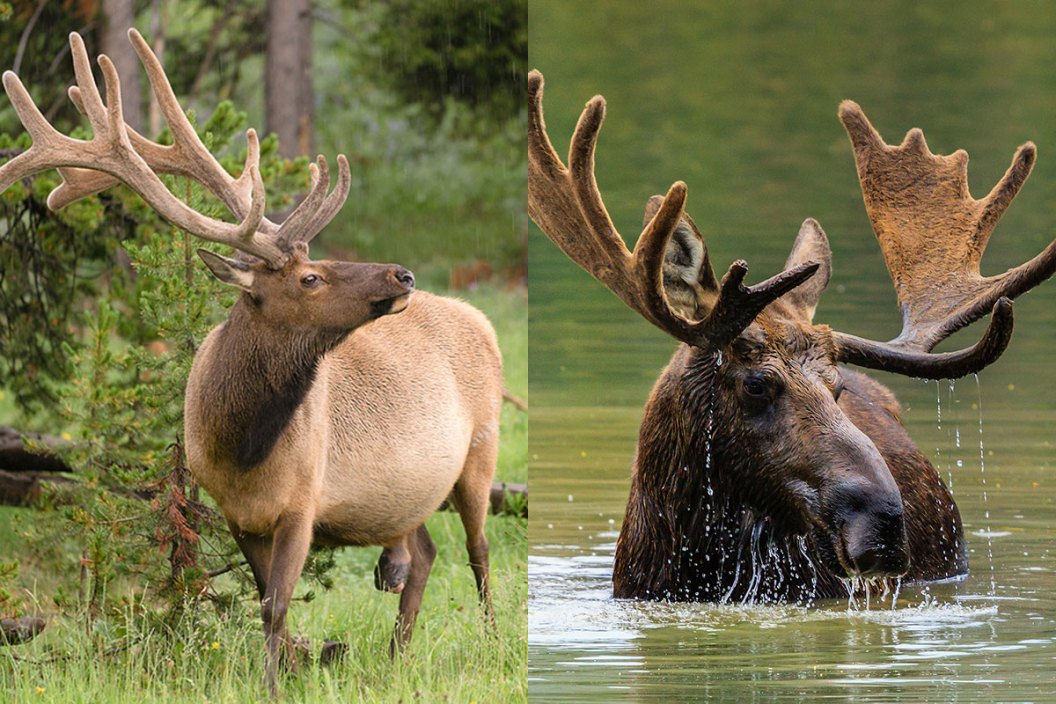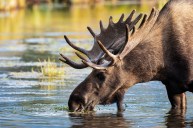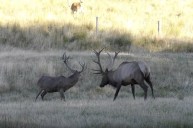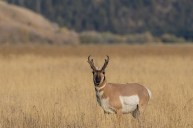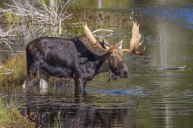Moose and elk are two of our favorite big game animals. They are both wily and difficult to hunt, and their game meat, when properly prepared, is delicious. As some of the largest land animals in the United States, they are also two of the best animals to target if you're looking to fill up your freezer quickly for winter. Both species' bucks also sport impressive antlers that make a phenomenal trophy for any hunter or shed hunter.
Hunting each animal requires a lot of time and physical effort, and, depending on where you're hunting, some luck in getting a tag. If you only have the resources—and freezer space—to hunt one each season, how do you choose between a moose or an elk?
We've laid out the basics in the moose versus elk debate, including size, habitat, hunting style, and meat. It's up to you to choose which you'll target next season.
About the Moose
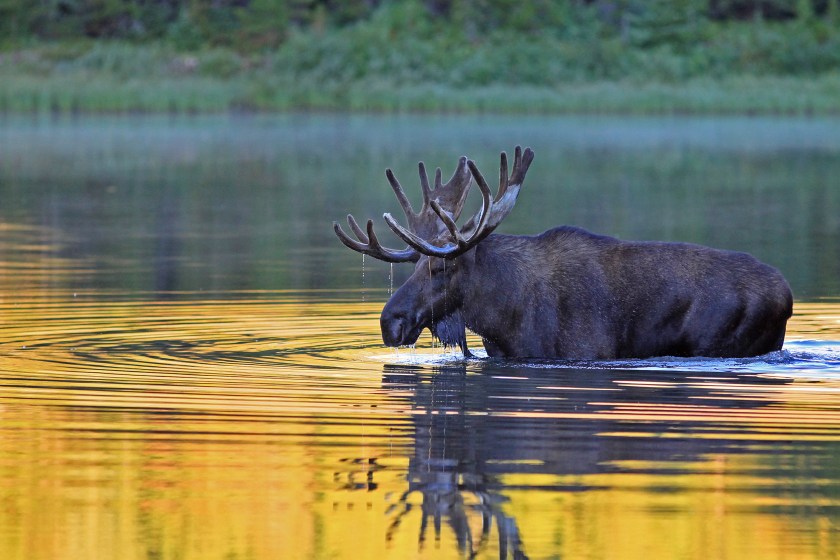
Getty Images, Alexey Korolkov
Let's start with the Alces alces, a.k.a. the moose. As the largest member of the deer family, this big boy is generally a slow creature but can move very fast and become extremely aggressive when angered or caught by surprise.
Moose's dark brown hair is hollow, which provides the animal with some serious insulation against the cold. Along with their wide hooves for ease of travel in deep snow, these adaptations make them one of the best-surviving creatures in the northern hemisphere. They also make it very difficult for them to live in warmer climates, so moose seldom wander south of the northernmost U.S. states.
Both male and female moose sport a dewlap under their chin, which is a fold of skin that's thought to be used as a visual and olfactory signal, presumably as a sign of dominance for male moose. Bull moose are far larger than cow moose and also sport massive antlers, which can span 6 feet and weigh 30 pounds. The antlers are palmate, meaning they are shaped like an open hand. Moose shed their antlers every year in the winter.
Solitary animals, moose are rarely seen in groups outside of the mating season, or when cows are with calves.
Moose populations live in northern Europe, portions of the northern and western U.S., and Canada. There are thought to be 300,000 moose in the U.S., with up to 200,000 of those moose in Alaska alone. According to the Alaska Department of Fish and Game, up to 7,000 moose are harvested in Alaska each year, yielding 3.5 million pounds of meat.
About the Elk
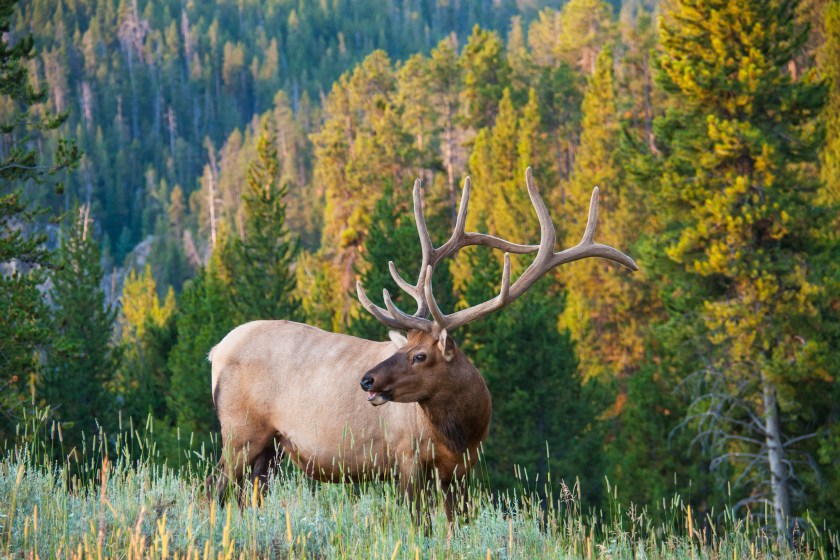
Getty Images, DJ38
The elk, also known as Cervus canadensis or its indigenous name, wapiti, is the second largest deer of the Cervidae family, often double the size of a mature mule deer. Elks' dark brown head and neck hair give way to a light brown color on the body, with a lighter, almost white or buff-colored rump. Their legs and neck are typically darker than the rest of their body.
Male elk antlers grow the same as all deer, shedding in the winter and regrowing in the spring. Elk have the same bone antlers as their relatives that grow up and away from their skull, sometimes with as many as six tines to a side for a real trophy.
Elk are highly vocal for an ungulate. The bull elk's distinctive bugle is used as a way to advertise their fitness to cow elk and show off to male elk. They also have two canine teeth called ivories, which scientists believe are remnants from tusks that ancestral species of elk used in combat. Like moose, elk are herbivores and typically dine on grass and forbs.
One of the key differences from moose are that elk are sociable creatures and are seldom found without other elk nearby. Typically, they live in herds of up to 400 animals strong. Elk range primarily in the western part of North America, although there are some small but viable populations in the eastern U.S.
Moose vs. Elk: Size
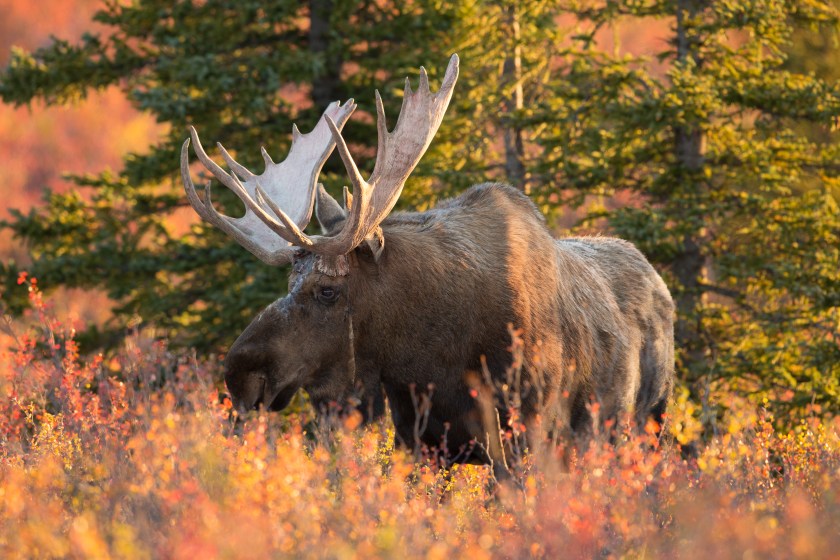
Getty Images, rpbirdman
While elk are one of the bigger species of deer in the world, moose are the largest, making them the clear winner in terms of sheer size. In fact, moose are the second largest land animal in all of North America, after bison. Alaska moose can weigh up to 1,650 pounds, with bodies up to 10 feet long and standing 6 to 7 feet at the shoulder.
Elk, on the other hand, weigh 1,200 and stand 5-1/2 feet at their shoulder at their largest—and only one species, the Roosevelt elk, gets that big. Tule elk, found in California, are far smaller, with tule bulls weighing about 500 pounds and cows only weighing 300.
This massive size difference between the different species also affects how much game meat each animal produces. An Alaska bull moose can yield 500 pounds of meat, while elk bulls yield 200 pounds.
Moose vs. Elk: Habitat
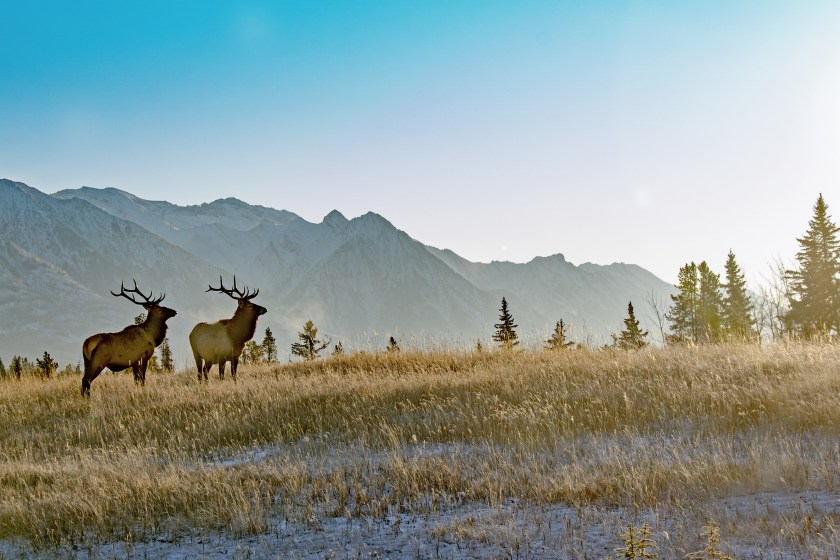
Getty Images, wwing
As mentioned, Moose are found in the northern regions of the United States, from Maine to Washington, and throughout Canada and Alaska. With their insulating fur and large size, moose thrive in colder climates and generally don't stray too far south, though their western range stretches into the Rocky Mountains, where the higher elevations provide cooler climates. Moose typically prefer forested areas, particularly ones that are regrowing after a burn, with plenty of ponds and streams. The animals are fantastic swimmers and often dine on aquatic vegetation.
Elk, on the other hand, are confined mostly to the western United States and six Canadian provinces, all the way down into New Mexico and Arizona, as well in as parts of Asia. Elk thrive in a variety of environments, including rainforests along the Pacific coast, sagebrush flats, prairies, and mountains. They aren't as restricted by warmer temperatures as moose are, though they thrive in mountainous regions and often dwell at higher elevations in summer, migrating down slope for winter. Places like Yellowstone National Park have an abundance of elk herds.
About Moose Hunting
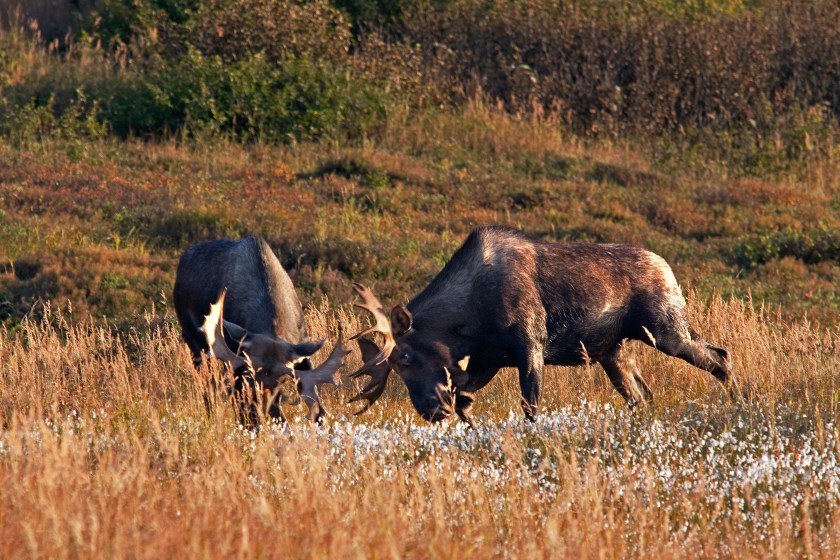
Getty Images, Alaska_icons
The size and stature of moose make for a truly memorable game animal to hunt. For many serious North American hunters, moose hunting has reached bucket list territory.
You may think that moose hunting begins and ends in places like Alaska, British Columbia, and Alberta, Canada, but areas like Maine and New Hampshire in the eastern United States provide quality hunting opportunities as well. You can also hunt moose in Colorado, Idaho, Montana, North Dakota, Utah, Washington, and Wyoming.
Virtually all of these locations have lottery-based drawings for moose tags, with some being more difficult than others to obtain. Smaller states have fewer opportunities, while the larger ones provide better chances of a quality hunt. Alaska is flush with moose, and a moose hunt for residents is a pretty simple affair. If you are not a resident, you'll need to be accompanied by a guide.
Moose calling is a common part of moose hunting, and mimicking their vocalizations can help bring them in closer. Large caliber rifles and fast-shooting bows are in order, as inadequate firepower can be a recipe for disaster with an animal this big.
Spot-and-stalk hunting is a common strategy when pursuing moose. The real work begins after successfully downing one. Even experienced hunters can take hours to fully field-dress a moose, and packing moose meat out of a backcountry situation is one of the tougher feats to accomplish. Many hunters use four-wheelers, bush planes, or boats to help them haul meat out of the backcountry.
About Elk Hunting
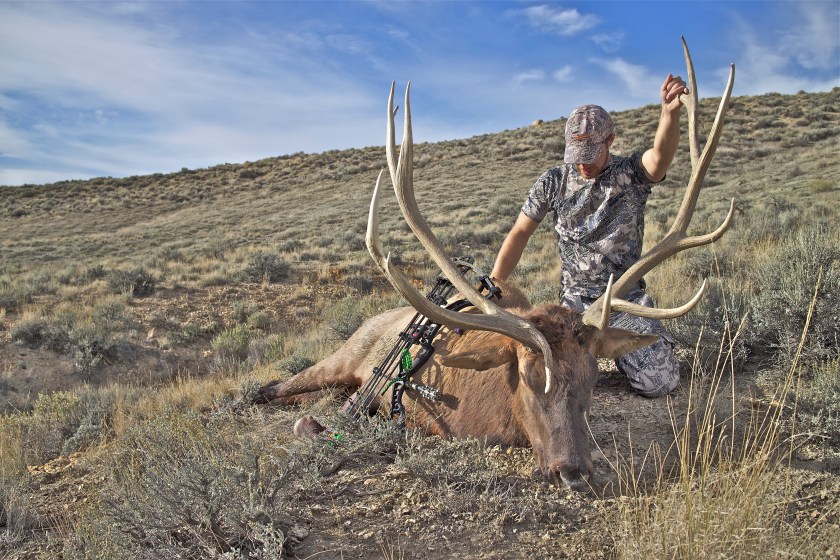
Getty Images, Rodneymac
Elk hunting offers by far more opportunities than moose, due to the sheer number of animals and states where they live. Elk hunts can be planned for a variety of states and areas, depending on what subspecies of elk you are targeting. Roosevelt elk, the largest subspecies, are mostly in the Pacific Northwest, while Rocky Mountain Elk, which yield the best antlers, are (unsurprisingly) in the Rocky Mountain states.
Colorado alone has an elk population of around 280,000 animals, making it a top destination for elk hunters. The population in Pennsylvania is stable enough to support a lottery draw hunt each year. You can hunt Alaska's elk population on Kodiak Island. You can also hunt elk in Arizona, Idaho, Michigan, Minnesota, Montana, Nevada, New Mexico, Oregon, Texas, Utah, Washington, and Wyoming. Depending on the area, elk tags are sold over the counter or have to be "won" through a lottery drawing. States that have more elk, such as Colorado, Idaho, and Montana, are easier to get tags in.
Elk Bugles, Eyesight, and Sense of Smell
Bulls begin bugling during the breeding season, which peaks in late September in most areas. Anyone who has heard this distinctive sound coming from the morning mist will tell you that it's this communication that makes elk so fun to hunt. While bulls can feel the hunting pressure and disappear into uncharted areas, it's not hard for hunters to lure them back into bow range using the right calling techniques.
Elk, unlike moose, have phenomenal eyesight. Combined with their sense of smell, elk are much tougher to stalk and shoot. This is especially true because they travel in herds, with plenty of sets of eyes to see your movement and nostrils to pick up your scent. The best tactic for elk hunting is to study the movements of the herd. Find a spot far from the road to hide in, and work on calling in your bull.
As with moose, elk can be a serious load once you get one on the ground, so make sure you're in good shape to be able to deal with the task.
Elk Meat vs. Moose Meat
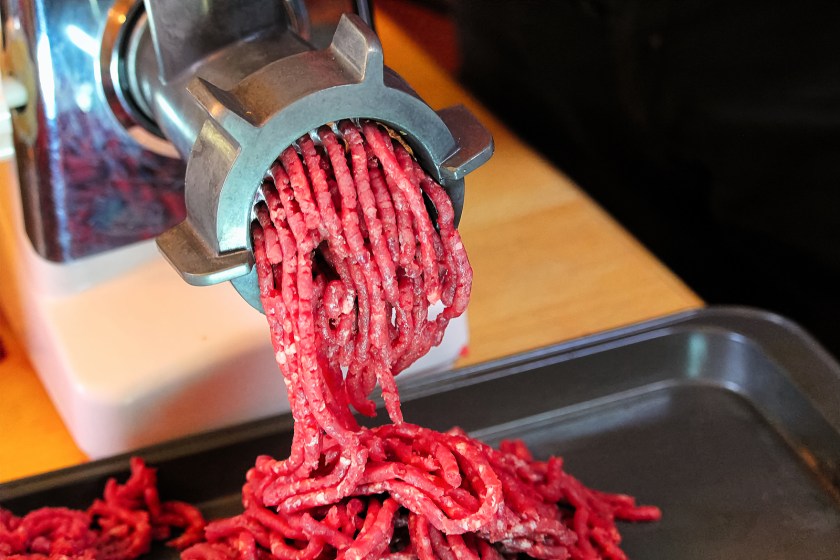
Getty Images, Wirestock
The antlers or taxidermy mount of an elk or moose can serve as a fine trophy. We still believe the game's meat is the main value of these large hoofed creatures. But the flavor, texture, and overall quality of moose meat and elk meat can vary, as can people's opinions about them.
With an animal this large, whether it be a moose or an elk, it's vital to take proper care during the processing. Take all of the precautions necessary to keep your meat clean and high quality.
Generally speaking, moose meat has a stronger flavor but is more tender than elk meat. Like any game animal, the taste of meat often depends on what the animal's diet is. Because they have a comparatively rich diet, moose tend to have a gamier taste.
Because Elk mainly eat grasses, the meat has a less gamey flavor. Elk meat is subtle and savory and still quite tender. Its flavor is a lot like lean beef.
One thing's for sure. Individual moose and elk can both provide abundant amounts of meat. Imagine a large freezer stocked full with meat. Steaks and roasts are common fare. But grinding moose meat or elk meat for burgers can make for great eating too.
The Bottom Line on Moose vs. Elk Hunting
Quite frankly, you can't really go wrong whether you choose an elk or a moose to target next season. Both animals are worthy adversaries, with fantastic trophies and hundreds of pounds of tasty meat to claim.
There are more elk in the Lower 48 and therefore more hunting options. Moose and moose tags can be harder to come by, unless you're an Alaskan resident. Moose are also generally solitary and more difficult to find. Elk gather in numbers, and bulls can be more easily called in. All that said, moose yield far more meat than elk and typically have more impressive antlers.
Deciding which is the better species to target is up to the individual. The next step is to go hunting or walking in the woods and decide for yourself.
